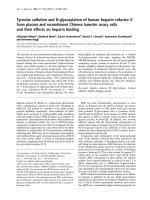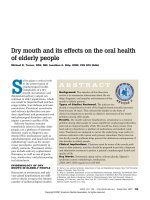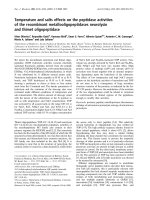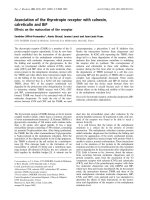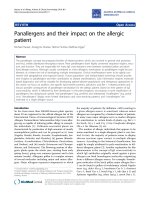Exploring repressed desires and their effects on the emergence of varied kinds of violence in the selected novels of stephen king
Bạn đang xem bản rút gọn của tài liệu. Xem và tải ngay bản đầy đủ của tài liệu tại đây (233.52 KB, 6 trang )
Exploring Repressed Desires and Their Effects on the Emergence of Varied Kinds of
Violence in the Selected Novels of Stephen King
[PP: 44-49]
Dr. Hoda Shabrang
Department of English Language and Literature, Khatam University
Tehran, Iran
Mohsen Amely
(Corresponding Author)
Department of English Language and Literature, Khatam University
Tehran, Iran
ABSTRACT
This research provides a psychological review of Stephen King's Misery and The Dark Half
based on Slavoj Zizek's ideas of violence and its veiled dimensions. In this investigation, the issue of
encountering violence promptly and abominating all kinds of violence in the actions of human beings
as well as commiserating with victims have been scrutinized. There are diversified critical assumptions
to the statement of what psychology is considerably worth applying to the works of Stephen King who
has gained achievements as a gothic author and who has paid attention to unconscious gothic
components and psychotic characters. It can be argued that these two novels reveal the doctrine of
violence which is the result of dualism and failure in attaining interior desires as explained in Slavoj
Zizek's conceptions: subjective and objective violence (symbolic and systematic violence). For the
reason that Stephen King is referred to as a gothic novelist, this research will concentrate on the leading
characters' psyches in two of his most thrilling novels to determine if the author's ideas keep in line
with the definition of psyche and unconscious are effective in the representation of violence,
trepidation, affliction, torment and madness and of the protagonists in Stephen King's Misery and The
Dark Half. As a theorist and a philosopher, Zizek emphasizes on the doctrine of violence and its effects
on changing the mood and on carrying out frenetic activities. Consequently, it is being explored that
unfulfilled intrinsic and intellectual desires in the real world and truly the potential uncertainties of
mental demands and the unfulfillment of these desires in the real world, novel's characters as well as
individuals can cause violence in the society.
Keywords: Psychoanalytical Criticism, Slavoj Zizek, Subjective violence, Stephen King, Gothic
Elements
The paper received on
Reviewed on
Accepted after revisions on
ARTICLE
INFO
13/05/2020
20/06/2020
05/01/2021
Suggested citation:
Shabrang, H. & Amely, M. (2020). Exploring Repressed Desires and Their Effects on the Emergence of Varied
Kinds of Violence in the Selected Novels of Stephen King. International Journal of English Language &
Translation Studies. 8(4). 44-49.
1. Introduction
One of the most experienced
American gothic writers who has found
much success in gothic literature in the 21st
century is Stephen king (September 21,
1947). His style in writing was the usage of
“author characters" as protagonists in the
novels such as Paul Sheldon who is the main
character in Misery, as well as Thad
Beaumont in The Dark Half. Stephen King
wrote several books under a pseudonym,
Richard Bachman. Darkness and cynical
atmosphere were the main characteristics of
Bachman
novels
rather
than
the
psychological gothic style common in many
of King's famous works. He wrote The Dark
Half which is about an author with an
ominous leechlike twin in response to his
expedition under the pen name of Bachman.
Therefore, King's novels include how to
depict the emotions of hope intermingled
with his own personal incidents and
horrifying elements. He keeps using clear
imagery which is set in a realistic place as
well as symbols and unique characterization.
King looks for unifying and exploring gothic
elements with strong significances of
psychological analysis. The gothic novels
have been included the images of shadowy,
retaliation, agony as well as hereditary
secrets. The role they play in the formation
of individuality and psychological impacts
on the mind is very notable. Stephen King is
an author who helps the development of
modern horror fiction. He is best known for
“the father of horror" in literature. He wrote
Exploring Repressed Desires and Their Effects on the Emergence of Varied …
contentious novels, which deal with the
illustrations of different personalities under
the impact of unfulfilled desires of the
protagonists. Many important elements such
as blood, wound, gothic components,
trepidation, and affliction are to be analyzed
in the works of Stephen King for which he is
best known. But the most important one is
the
various
psychological
notions
recommended in this study which can be
extended to the society in the real world as
well. This research strives to investigate
King's novels on grounds of components
such as horror, torment, violence relied on
which the society formed its norms. In
Misery and The Dark Half uniformities can
be seen between Slavoj Zizek and Stephen
King. Both suggest the concept of violence
and its impacts on the society as well as the
relationship between savagery and veiled
layers of social structures. So Zizek's
doctrines of violence are to be discussed in
King's selected novels to see how this
renowned author keeps in line with modern
tendencies in his main characters and social
structures. The central issue that the current
study is going to investigate is to see how
King delineates the conventions of violence
(subjective violence and objective one) in
his novels. It is obvious that the conception
of violence is regarded as an idea which is
compelled by social systems.
King's novels according to gothic
elements such as terror and torment strive to
indicate the concept of " dualism " which the
society scrimmage with it in a large scale on
account of the unfulfilled desires of
individuals that sabotage the entire being of
the society. What distinguishes King from
his companions in the field of gothic
literature is the belief that lack of
consummating human wishes can bring
dualism in characters' personalities, which
raise problems for the individuals
(Hitchcock, 2014, pp. 7-10).
Therefore, repressed desires can
cause violence in the social-familial
structures. So the mere solution is paying
much more attention to these desires in order
to have a dynamic, healthy as well as
unwearied society. Regarding to the major
notions of violence (subjective and objective
ones) by Slavoj Zizek, the following
questions are debatable in the Stephen
King’s selected novels:
How do Misery and The Dark Half
depict subjective and objective violence?
How does the process of violence
reveal itself in the diabolic characters of the
novels?
Hoda Shabrang & Mohsen Amely
This article tries to debate these
questions and find an appropriate result in
order to solve one of the major problems
with which human beings are contending
2. Approach and Methodology
The method chosen to demonstrate
how unfulfilled repressed desires of
individuals can cause violence in the real
world as well as society emphasized by the
theory of subjective and objective violence
in Stephen King's Misery and The Dark Half
as a valid study. One of the Stephen King's
main themes is the quarrel between the
individual and the hidden personalities
which are shown in the dual personalities of
Misery's Annie Wilkes as well as The Dark
Half's Thad Beaumont. The sudden change
in the mood of the characters means as a
contradiction of heartlessness in the
captivation the reader and victim feel toward
the very power that threatens them (Spector,
1984). Violence as it indeed becomes
discernible in realistic conditions is about
the interlacing of humankind sensations of
fright, fury, and agitation in such a manner
that cross exactly the traditional ethics of
usual status. It is merely this surprising and
abrupt trait of violence as it in fact provides
hint to the sentimental ever changing at the
core of the assumption of violence (Collins,
2008, p. 4).
People believe that violence is the
manifestation of our animality, bursting
when learned cultural regulations failed.
Violence is also viewed to be the gist of
devil; it is the paradigm system produces of
depravity. Nevertheless, the review of
violent actions and habits throughout
cultures and within history demonstrates
only the contrary when people wound or
murder somebody; they commonly achieve
this goal because they believe they have to.
They believe that it is ethically correct or
even compulsory to be violent. In addition,
the impulses for violence broadly develop
out of a linkage between the culprit and the
victim. The criminal is brutal to make the
relation proper_ to make the connection
what it should be based on his or her cultural
appliances of worldwide kindred righteous
tenets. That is, most violence is ethically
prompted. Integrity is about controlling
societal relations, and violence is one
method to manage relations.
In lieu of encountering violence
immediately, Zizek’s recent book forms six
sideways views. There are causes exploring
the matter of violence. The fundamental
assumption is that there is something
essentially enigmatic in a direct struggle
International Journal of English Language & Translation Studies (www.eltsjournal.org)
Volume: 08
Issue: 04
ISSN:2308-5460
October-December, 2020
Page | 45
International Journal of English Language & Translation Studies (www.eltsjournal.org)
Volume: 08
Issue: 04
ISSN:2308-5460
October-December, 2020
with it: the compelling fear of violent
actions and compassion with the victims
relentlessly act as a temptation, which
impedes us from thinking. A disinterested
theoretical growth of the classification of
violence have to overlook its painful effects.
Moreover, there is a perception in which an
aloof scrutiny of violence somehow
duplicates and contributes in its fright. At
the same time, the evident signs of violence
are actions of malefaction and horror, social
upheaval, universal combat.
Zizek has been elected for the
intention of this research because of his
main idea on the expansion of frequent ideas
of violence, which means “subjective
violence" which reflects the intentional use
of power to impose on trauma or on human
beings wound towards social injustice as a
systematic violence (Zizek, August 2008,
pp. 11-12). In this article violence towards
human beings especially for social purposes
is explored. Psychological pressure, intense
paltriness and intimidation as well as
different types of torture are the influential
elements in creating violence (Van der
Linden, January 15, pp. 3-7). Zizek
expresses violence by noting, “when we
think about violence we tend to think about
criminal acts, acts of terror, civil unrest and
war." On his account if we wish to
understand violence, we must refuse the
'fascinating lure' of this type of subjective
violence that is "violence performed by a
clearly recognizable agent" and we must
look at the violence in the background that
generates subjective violence, which is
called objective kind of violence (Zizek,
August 2008, pp. 9-11). Objective violence
is a kind of violence which is unseen since it
suffers the zero level standard against which
we comprehend something as subjectively
violent. This sort of violence is divided into
two categories: "symbolic violence" which
reflects the violence embodied in language
and its forms and "systematic violence"
which points to the catastrophic outcomes of
economic systems or injustice in order to
evaluate the differences between systematic
violence and subjective violence which is
too easily adopted in the society but the
social roots of violence are often ignored
(Zizek, August 2008, pp. 12-15). Zizek
asserts, “It is difficult to be really violent; to
perform an act that violently disturbs the
basic parameters of social life" (Zizek,
August 2008, pp. 205-209).
Stephen King is a novelist who
undoubtedly refers to a temple of multiple
sterling authors in the category of horror
fiction. Critics like Anthony Magistrale,
additionally accept the truth that King
establishes the mere literary offspring
dropped from the writers such as Edgar
Allan Poe and Howard Philips Lovecraft
(Magistrale, March 1992, p. 27).
Works of horror are organized to
evoke a certain kind of influence. Violence
is always distinguished as the impressment
of physical force so as to wound, and the
word usually represents drastic human
devastation of belongings or injury to
individuals, usually intentional and forceful
verbal abuse that injures others (Valentic,
pp. 1-5).The introduction for language and
formal rejection of violence are often
understood as two dimensions of one and the
same characteristic: "speaking is the bedrock
and structure of socialization and it is to be
distinguished by the abandonment of
violence." In a particular social context, all
correlations with others can be regarded as a
balance of forces; and injustice is a result of
a lack of harmony of forces in which the
weaker is tyrannized and oppressed by the
stronger. The aim is to create a balance in
which everyone's rights are respected; it
follows the action for justice (Muller, 2002,
pp. 23-25).
3. Discussion
The intention of this study is to read
Stephen King's Misery and The Dark Half as
well as to plumb human being's psyche and
his or her unfulfilled desires and psychic
constitute and how the concept of violence
and its divisions influence the main
characters in those selected novels. As a
gothic novelist, telling stories of horror
genres, Stephen King's beliefs, both
psychoanalytic and otherwise, can be seen
through the main characters he produces. As
the relations between the characters indicate,
he does believe that the characters can
emphasize on the stories from the others'
perspective. Because of the capabilities of
King's works in depicting psychological
disorders, Zizek's notions of subjective and
objective violence can function as
appropriate hypothetical background to
negotiate their relationships in question.
Therefore, a large amount of the significance
of this scrutiny emerges from the harmony
between King and Zizek that can bestow
upon a deeper recognition of both. Reviews
of Stephen King's Misery and The Dark Half
concentrated on trepidation, psychological
disorders, physical tortures and categorized
it as both narrative and gothic fundament.
Cite this article as: Shabrang, H. & Amely, M. (2020). Exploring Repressed Desires and Their Effects on the
Emergence of Varied Kinds of Violence in the Selected Novels of Stephen King. International Journal of English
Language & Translation Studies. 8(4). 44-49.
Page | 46
Exploring Repressed Desires and Their Effects on the Emergence of Varied …
On a deeper level, the researcher hopes to
uncover King's narration of psychopath
characters through a study of horrifying
forms he exploits within his works and how
they interact with lines of psychoanalytical
theories. In particular, King's novels
(especially, Misery and The Dark Half) lend
themselves to a discussion and analysis of
psyche and problematic backgrounds. King's
novels often represent the psychotic
characters in both zenith moments and
extemporary actions. The lack of stability in
the character's personality and psychological
disorders as well as the sense of horror,
violence, torture and torment are highlighted
in these novels. The supreme purpose of this
article is to use Zizek's critical view for
novels to show the complexities of
psychological
problems
and
more
importantly, the concept of violence that is
revealed through different types of tortures
(Harris, August 2004, pp. 199-200). Torture
is among the repulsion of human revelations,
any action by which harsh, hurt or torment,
whether bodily or psychologically is
deliberately imposed on an individual for
such intentions as gaining from him or an
absentee information or a declaration,
pushing him for an action he has done or
threatening, or compelling or for whatever
reason in accordance with discernment of
any sort where such ache or torment is
imposed by or at the abetment of or with the
agreement or compliance of a public formal
capability. The chief target of torture is not
always to oblige the prey to squeal and
supply information; it is to disintegrate the
identity of the prey. The wound consists in
the devastation of the personality (Elsass,
1997, pp. 2-10)
Violence is a manner that has little or
no equivalent. Exists in the dens, couple of
hundred thousand years ago, it has endured
every individual's community's effort to
annihilate it. As a whole, violence is hostile
manner with the purpose to provoke injury
(bodily or mentally). The word purpose is
essential; bodily or mentally harm that
happens inadvertently, in the deficit of
purpose, is not violence. Violence does not
merely "appear" in the healthy grownups; it
is an adult ethological disorder that is
advanced by distressed manners during
childhood (Denno , 1990, p. 85). Cassel
(1982) mentions in a scrutiny of the quality
of suffering that it achieves its peak what it
threatens to liquefy the individual's honesty.
Even if the suffering is rooted in physical
ache, it is the mental element which is the
effective kernel of the suffering and which
Hoda Shabrang & Mohsen Amely
terminates when the ache menaces to
demolish the individual's integrity and purity
(Cassel, 1982, p. 640). Torture is a political
rite that happens in the developing countries
to an ever-growing scale (Agger, 1991, p.
142). “it is part of ' the liturgy of
punishment', and shall satisfy two
requirements: to mark and dishonor its prey,
and to have an intimidating influence."
(Foucault, 1977, p. 35). The significance of
this study according to the methodology of
Slavoj Zizek is to explore that the unfulfilled
intrinsic desires of the novels' protagonists
as well as the real world's individuals that
will lead to violent behaviors. Therefore, in
case of creating conditions in which
repressed desires of the individuals whether
in the fictional world or the real world from
their childhood to the youth are fulfilled
correctly and positively, it is not to be
witnessed such ill and violent behaviors in
the novels as well as extensive level of
society.
Misery seems an appropriate novel for
psychoanalytical study for its use of
psychopath character as a central element to
scrutinize the psychological problems within
the baleful characters. When the heroine
demands failed, she tries to show her true
personality. This novel reveals dualism in
the personality of the protagonist and her
mental disorders. So it is great to say that
Misery is categorized as a gothic as well as
psychological kind of novel. However,
King's The Dark Half also chooses to
indicate the darkness behind the real
character which leads to a catastrophic
outcome and results in the unfulfillment of
the desires of the protagonist of this
outstanding novel. These novels have a
suitable content in which dualism and
mental disorders are revealed properly.
Hoppenstand and Browne in "The
Horror of it all: Stephen King of the
American Nightmare", call Misery, "a thinly
unclear contemplation of the thousands and
desires of his proponents and his writing
style of his works" (13). However, Misery is
also a psychological gothic story without the
metaphysical-a dreadful narration of the
reality of everyday life, of oppressed fears,
of suffering, annoyance, solitariness, dander
and anxiety, mental disease, psychological
state and fragmentation (96).
Torture is differentiated from other
harsh harrowing conditions by depicting an
excessive form of violation of both
psychological and physical character and by
an unambiguous target in a particular
situation. Torture is aimed to people and
International Journal of English Language & Translation Studies (www.eltsjournal.org)
Volume: 08
Issue: 04
ISSN:2308-5460
October-December, 2020
Page | 47
International Journal of English Language & Translation Studies (www.eltsjournal.org)
Volume: 08
Issue: 04
ISSN:2308-5460
October-December, 2020
groups with a special goal of causing harm,
obliging conformity and ruining political
desire, roughly in the deficiency of war
(Sominier. F and Genefke, I, 1986).
Slavoj Zizek's Violence: Big Ideas /
Small Books, argues understanding violence
(subjective and objective violence) and its
manifestation in the society, especially
related to social interests, subjective
violence refers to violence that is performed
by an individual mostly criminal actions or
terrorism. Therefore, objective one has no
clear culprit and neglected in the
background of subjective violence. For
example, the branch of systematic violence
which is categorized in the objective
violence, is the sign which is revealed
through the language of the protagonists of
the selected novels. Zizek refers to different
kinds of violence, which are depicted and
perceived in the social circumstances (Zizek,
August 2008, pp. 9-11). Zizek distinguishes
between those two kinds of violence in the
context of state violence, social agitations
and practice of tolerance and language itself
as a sign of liberal thought (Zizek, August
2008, pp. 15-20).
Zizek presents a deeper challenge to
the norm that many realize and compel us to
determine what kind of relation his work has
to the standard form and ordinary conditions
of the society that sustains them. Zizek has
arrived at the conclusion that no ethical act
can be strictly guaranteed by existing fact
and the ethical act must require a breaking
of existing fact (Galt Harpham, Spring 2013,
pp. 467-469).
As it was mentioned before, the aim of
this article is to show the relationship
between mental disorders which are
originated in the unfulfilled desires of the
characters and their violent actions during
their lifetime. This linkage is a unique and
perceivable issue, which lead human beings
to brutal punishments, murder, trepidation,
torture. This article attempts to depict the
manifestation of mental disorder through
violence whether in the fictional world or
the real world. If language is a manifestation
of a person’s unconscious psyche, Misery is
quite a reliable source to perceive the
unconscious assumptions of the famous
novelist, Paul Sheldon, who is abandoned
far from home by his number one proponent,
the Dragon Lady. Similar to most of King’s
fictions, he exploits a limited omniscient
narrator that gives us all information about
Paul’s ideas; with the ones that are silent in
italic
form.
Additionally,
Paul’s
consciousness has felt a new reality as he
stays wounded and sick-abed in the bedroom
of Annie Wilkes’s house in Sidewinder,
Colorado. Primarily, his delight mainly
reflected his “agony”, “confusion” and
“alleviation” as truth (King, Misery, 1988, p.
7).
Paul began to be familiar more and
more with Annie Wilkes and with the
developing cognition of her; he was able to
control how he should behave towards her.
He was dissolving her hideous reality
because Annie did not protect him from her
animosity. Finally, Annie’s torments grew
more austere when she became furious. For
instance, when she fed him from the bucket
that had water used after cleaning the wall,
to which soup was splashed out of Annie’s
furious. Paul knew Annie and recognized
something about her that aided him to plan
his flee and in order to victoriously do so, he
had to handle his demand of revealing his
pain. Furthermore, the tortures that he had
tolerated were the manifestation of the
Zizek’s concept of subjective and objective
(symbolic) violence depicting through the
role of the protagonist. On the other hand,
these tortures resulted in the unfulfilled
desires of Annie Wilkes, which were shown
via suffering the victim (subjective
violence), and insults in the utterances of her
(symbolic violence).
Psychopath
individuals
have
completely lost connection to reality and
impute aggressive ideas and purposes to the
other people. These issues are continuously
doubtful and cynical, sensitized to scorn,
with an inclination to assign malevolent
purposes, they do not forget a snub and
always await for struggle and attack other
people in the society. Therefore, the
manifestation of this kind of violence within
the social groups is related to Zizek’s
subcategory
of
objective
violence:
“systematic violence”. Individuals with this
disorder (mental illness) attack alone and
may do violent actions against other people,
as well as crimes against racism, which
leads to social anarchy and chaos. Violence
in psychopath people is perhaps on the
extreme. It is a kind of violence, which is
related to lack of emotions towards other
people. For them, violence is emerged from
their unfulfilled desires during their lifetime,
which lead to aggressions, as they are
reacting to the fictional world of their
unconscious psyche, and irrational desires.
Therefore, their actions in the real world are
unexpected and accordingly temperamental.
Cite this article as: Shabrang, H. & Amely, M. (2020). Exploring Repressed Desires and Their Effects on the
Emergence of Varied Kinds of Violence in the Selected Novels of Stephen King. International Journal of English
Language & Translation Studies. 8(4). 44-49.
Page | 48
Exploring Repressed Desires and Their Effects on the Emergence of Varied …
4. Conclusion
In both Misery and The Dark Half,
the
author-protagonist
experiences
difficulties, which influences the manner
through which they act appropriately. The
leading characters closely involved in the
demonstration of these difficulties, Annie
Wilkes and George Stark, behave in ways
that destroy Paul and Thad’s sense of selfconfidence. Therefore, Paul and Thad,
authors snared by their own textual
composition, also suffer from another
entrapment: a trap within the psyche.
Astutely toying with the concept of the death
of the writer and the Gothic duple, Stephen
King produces protagonists so realistic and
extremely profoundly linked to him that they
are particularly more non-fiction than
fiction. King’s specific usage of the Gothic
duple relates his main characters to real life
and world.
These famous novels demonstrate
the impact of the unfulfilled desires on
changing the mood and doing frenetic
activities of the individuals. These novels
show dualism and psychological disorder in
the personalities of the main characters.
Violence occurs in the universe
around us. In a terrifying way, Zizek asserts
that, “In the time it takes you to read this
paragraph, ten children will die of hunger”
(Zizek, August 2008, p. 7). The events in the
two novels are the external aspect of what
Slavoj Zizek believes as violence which
means the conceptions of horror, trepidation,
affliction, torture and torment according to
which the hidden personalities of the human
beings being affected. Gradually, Annie
Wilkes' or George Stark's unfulfilled desires
lead to madness, torture and violence.
Therefore, characters are trapped in the illperformed psyche and psychological
disorders, which also cause them to act
inappropriately in the society. The
protagonists of the novels: Annie Wilkes
and George Stark both got stuck in the
irrational demands and desires which cause
them to torture their victims and to act
madly in the society. So if the intrinsic
desires remain unfulfilled, there is no escape
from the society in which torture, violence,
trepidation and torment are done violently
and eternally. Therefore, the mere solution is
to pay close attention to the demands and
attempt to fulfill them on the basis of the
norms of the society. Accordingly, this study
strives to show how the claim support
effective understanding of the research
problem.
Hoda Shabrang & Mohsen Amely
References
Agger, I. (1991). The Power of Shame:
Testimony
of
Exiled
Women.
Copenhagen.
Cassel, E. (1982). The Nature of Suffering and
the Goals of Medicine. New England
Journal of Medicine II, 639-45.
Collins, R. (2008). Violence: A Microsociological Theory. New Jersey:
Princeton University Press.
Denno , D. (1990). Biology and Violence: from
birth to adulthood. New York: New
York. Cambridge University Press.
Elsass, P. (1997). Treating Victims of Torture
and Violence: Theoritical, Crosscultural, and Clinical Implications. New
York: New York University.
Foucault, M. (1977). Discipline and Punish: The
Birth of the Prison. Copenhagen:
Rhodos. Copenhagen.
Galt Harpham, J. (Spring 2013). Doing the
Impossible: Slavoj Zizek at The End of
Knowledge Critical Inquiry (Vol. 22).
Harris, S. (2004). End of Faith. London.
Hitchcock, A. (2014). A Dark Mirror Duality
and Reflections in Stephen King's
Writers.
Waco
Texas:
Baylor
University.
Hoppenstand, Gray and Ray B Browne. (1987).
The Horror of It All: Stephen King and
The Landscape of the American
Nightmare. The Gothic World of
Stephen King. Bouling Green: Popular
Press.
King, S. (1988). Misery. London: New English
Library.
King, S. (1990). The Dark Half. London: New
English Library.
Magistrale, T. (March 1992). The Dark Descent:
Essays Defining Stephen King's
Horrorscape. Praeger.
Muller, J.-M. (2002). Non-Violence in
Education. UNESCO.
Sominier. F and Genefke, I. (1986).
Psychoterapy for Victims of Torture.
British Journal of Psychiatry, 49, 32329.
Spector, R. (1984). The English Gothic. Green
Wood, Westport.
Valentic, T. (n.d.). Symbolic Violence and
Global Capitalism. 2, 1-5.
Van der Linden, H. (January 15). On the
Violence of Systematic Violence: A
Critique of Slavoj Zizek. (Radical
Philosophy Review), 33-51.
Zizek, S. (August 2008). Violence: Six Sideways
Reflections. Big Ideas / Small Books.
London, Great Britain: First Picador
Edition.
International Journal of English Language & Translation Studies (www.eltsjournal.org)
Volume: 08
Issue: 04
ISSN:2308-5460
October-December, 2020
Page | 49

